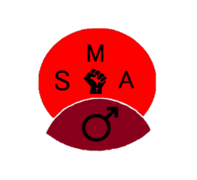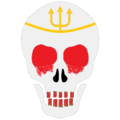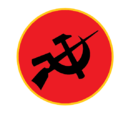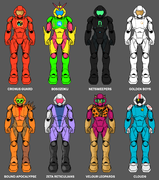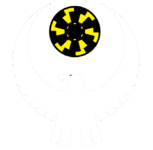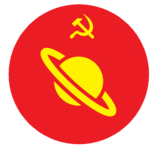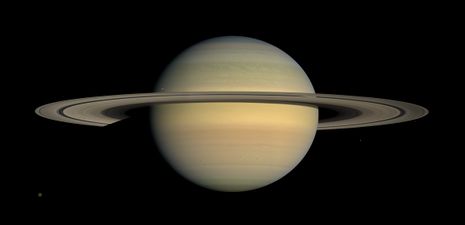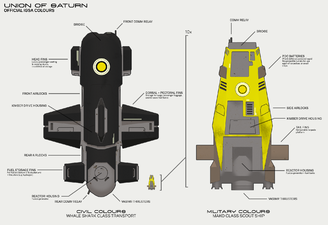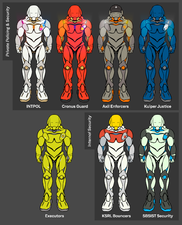Union of Saturn
| Union of Saturn | ||||||
|
| ||||||
| ||||||
| Motto | ||||||
| "Nowhere In The Rules Did It Say I Couldn't Cheat" (Executive motto, post-3770) | ||||||
| "When You're Tired of Saturn, You're Tired of Life" (Popular saying, post-2547) | ||||||

Saturn, with Titan in the foreground | ||||||
| Celestial State | ||||||
| Capital: | Huygens, Titan | |||||
| Largest City: | Xanadu, Titan | |||||
| Official languages: | Solar English (de facto) | |||||
| Currency: | Saturnian Dollar ($) | |||||
| Demonym: | Saturnian, Saturnite, Saturnine | |||||
| Politics | ||||||
| Government: | Corporate federated autocracy | |||||
| - President: | Thaddeus Valorant | |||||
| - Executive Director: | Melissa MacClellan | |||||
| Legislature: | Saturnine Executive | |||||
| Settled: | 2270 | |||||
| Formation: | ·2299 (Axil control) ·3109 (Union declared) ·3234 (Five States) ·3465 (Executive) | |||||
| Colours: | IGSA standard: (Civil) (Military) | |||||
| Demographics | ||||||
| Population: | 1 billion | |||||
| National minorities: | Earthers, Jovians, Titan Martians | |||||
| Geography | ||||||
| Planet: | Saturn | |||||
| System: | Solar System | |||||
| Avg. distance from Earth: | 1.2 billion km | |||||
| Orbital period: | 29.457 yr | |||||
| Moon(s): | 82 (incl. Dione, Enceladus, Iapetus, Mimas, Rhea, Tethys, Titan) | |||||
| [Source] | ||||||
| “ | Green business snakes latch onto Saturn and die like ticks. The planet moves with the bloating and shrinking of their pockets. And atop the pile, every time, is the Executive... | ” |
–Seamus Thornton, CEO of Axil Industries, 3895 | ||
The Union of Saturn (Martian English: Uunezaten) is an independent cluster of self-governing economic zones centred around the gas giant Saturn.
Ever since the collapse of its first colony in thermonuclear flame, Saturn has remained as the Solar System's third world on steroids, growing from a mining startup's wet dream to an anarchic patchwork of "states" headed by the Saturnine Executive, a congress of its largest companies. With its surreal and bastardised excuse for a history cutting its hamstrings and denying the formation of any true government, Saturn has instead chased the dragon of a truly free free market, fostering an anarcho-corporate way of life and becoming inhabited space's crown jewel of unbridled capitalism, exploitation, crime and decadence.
History[edit | edit source]
Primitive Landings[edit | edit source]
Orbited by scouting probes as far back as 1979 with the Pioneer 11, the first craft to touch down on a Saturnian orbital body was the Huygens, which landed on the Adiri region of Titan (modern day Hubert Curien Zone) on January 14 2005, with the next probe, the Dragonfly, landing in 2034. Missions would continue for the next two centuries, collecting information that'd prove vital for colonisation efforts in the millennia to come.
Colonisation[edit | edit source]
The Saturnian moon of Enceladus was colonised in 2270 - in the same window that saw the settlement of three of the four Galilean moons - following advancements in VASIMR technology, with pre-supply crates and satellites being sent to Enceladus and Titan as early as 2209. Colonisation was headed by the United Nations-aided "Saturn Next" initiative, a privately run conglomerate which saw to expand asteroid and gas mining efforts beyond Mars through the establishment of permanent bases around Saturn.
While Titan was favoured as the chief settlement destination, Enceladus's favourable launching conditions and abundant subsurface water made it a preferred candidate for early construction efforts. After a successful first landing, bare-bones habitation pods were erected, and autonomous drones were deployed to the surface of Titan to fabricate domed structures to support human habitation, with additional supply crafts arriving from Earth and the Main Belt in later decades.
Saturn Next would dominate colonisation efforts for the next thirty years, riding high on a speculation bubble of keen Earther investors as it oversaw colony grow to house several thousand permanent and semi-permanent workers, the majority of whom drawn from the poor and criminal elements of Earth and Mars to work in high risk "icer" jobs on moons or as "rock hoppers" in the Kuiper Belt. While the logistics of deep Solar colonisation were well-calculated by the UN (now renamed United Governed Space Authority) and Saturn Next's board of executives - which allowed the return of healthy profits - the colony's christening threat was the outbreak of the Martian War of Independence, beginning with the Tharsis General Strike of 2298, and later spreading to various other cities following a violent crackdown by Earther colonial troops.
Resistance spread to Saturn through the channels of the Martian Syndicalist Association who, despite heavy anti-union activity by Saturn Next, managed to infiltrate the ice pits of Enceladus with a significant presence of agitators and cardholding members. Hearing the news of Earth's response to the strike back at home, the Saturnian MSA voted with a two-third majority to strike in solidarity, downing tools and - despite opposition from the rank and file - linking arms with fellow Earther workers. Saturn Next Security - designed as a colonial police, yet staffed by a number of guards of a similar background to the miners - opted to stay lodged up in their barracks after several attempts at strikebreaking saw shots fired and the deaths of dozens of their own, and once corporate executive threatened to fire the entire force, which would have seen them stripped of weapons and stranded on a desolate moon hundreds of millions of kilometres away from home, the guard split down the middle, half reluctantly returning to pester the pickets, the other joining it. With their options cleaned out, Saturn Next accepted the reality and reached out to UGSA for help, with the organisation - learning the lesson from Mars - suggesting the company meet their workers' demands with a small pay rise. UGSA however, with its hands tied with the rapidly escalating situation on the red planet, could not offer the additional funds for such a raise, and in their desperation to keep their investors happy, Saturn Next instead contacted their colleagues in Axil Energy, a booming Earth-operated Main Belt mining corporation with a notoriously effective security force, the Axil Enforcers. In exchange for Saturn Next loosening up their monopoly stake in the Saturnian pie, Axil agreed to send a strike-breaking force of Enforcers to Enceladus by January 2299.
The arrival of Axil was bookmarked by an immediate bloodshed that would become known as the January Massacre. With initial attempts at arrest met with a well-defended armed resistance by the MSA, the Enforcers took to executing all identified ringleaders, with thousands more suspected members and sympathisers arrested or killed. In the heat of the conflict, the hard-boiled remnants of the MSA, various Earth miners, and the SN Security defectors, realising the disintegration of their economic power with the breakup of the strike, banded together. Headed by the sole remaining MSA custodian Sally Belleth, they successfully stormed the headquarters of Saturn Next and held its entire administration hostage. Hacking into the Saturn Next command computer, whose security was notoriously cheaply assembled and well understood by the workers who programmed it, the militia called upon the SN defence satellite Xi Guiying and programmed it to fire a volley of fusion missiles upon the orbiting Axil fleet. This plot was however preempted by the remnants of the SN Security, and stirred to life with the news of their brothers and sisters' turn to outright terrorism, entered the headquarters through its utility tunnels and besieged the barricaded command room. Fearing execution, and unwilling to let the Martian-led Solar workers' movement shrink to Mars alone, Belleth steered the Xi Guiying to target the SN Headquarters. In her final minutes, Belleth commandeered the Enceladean moon-wide announcement system and, evoking the writings of Mao Zedong, stated "If the imperialists insist on launching a Great Solar War, it is certain millions more will turn to socialism on Mars and the outer planets. For them, only Earth shall remain! Victory to the Dusters!".
The Xi Guiying fired successfully, and Saturn Next's headquarters were atomised in a ball of thermonuclear heat, taking the bulk of the SN administration, security force, and leaders of the Saturnian MSA with it. An emergency UGSA meeting was called on Luna, attended by the Earther Saturn Next CEO Gautam Mishra, Thomas Brady Axil of Axil Energy, and the Martian and Earther national representatives. As a PR-saving hand-wave the situation on Saturn was declared a humanitarian crisis, however talks broke down once it came down to squaring responsibility. Mishra, fearing the total discrediting of his company, put the blame on Mars's inability to prevent radicals from leaving their planet. The Earth representatives, whose interests were as colourful as their multi-national origins, were largely divided, with only a vague current of agreement centered on hurrying the end of the Martian War of Independence as soon as possible so to allow the return of peaceful deep Solar mining. The Martians too, a menagerie of pro-UGSA governors whose interests aligned when it came to selling Martian minerals to Earth, largely supported this decision, with one notable exception in the pro-independence populist Tharsis governor Daniel Yue, who berated the talks as a sham papering over the very real concerns of everyday Martians. Axil, seeing the event as an opportunity to expand his company, sympathised with Yue, and offered a peaceful solution through the way of free corporate enterprise. With Axil, he argued, Saturnian colonies would continue to mine the much-needed resources of the outer belt without bias to any national or quasi-national political power, selling resources fairly to all buyers, while keeping tight security with his tried-and-tested Enforcers. Through a slim majority of votes, Axil Energy then replaced Saturn Next as the chief of Saturn's colonisation, with additional space allowed for other corporations to stake a claim. To keep the planet under direct UGSA jurisdiction, Saturn was then zoned as a Stellar Condominium, an Antarctica-inspired special economic zone that'd become a template for the later Interstellar Zones.
In the coming years, as war continued to engulf the red planet, the ringed giant became host to a well-controlled Axil Energy colonisation program, with the company exploiting the distracted Mars and Earth until the cessation of the war and formalisation of the Union of Mars by 2314 to seize strategic mining sites and infrastructure. Once a full-strength UGSA presence resumed, they found a moon system teeming with Axil Enforcers and well-monitored, strictly-contracted workers.
Development[edit | edit source]
With Saturn stabilised and its moons opened to free market capitalism, various Earther and Martian companies (colloquially "inner corps") began to flush in, both seeking to soothe the economic pains of their changing climates and the recently subsided war.
For the next hundred years construction would continue on Enceladus and Titan, and settlement operations spread to all other moons and a swathe of lesser satellites, with self-sufficient domed cities sprouting up on Rhea, Iapetus, Tethys and Dione, and Kowloon Walled City like plastic and concrete favelas elsewhere. Alongside the growing population of miners there rose a plethora of auxiliary industries: fast food and groceries, gambling, financial and insurance services, logistics and transport, construction, IT and AI, amateur film and television, alcohol and drugs, sex work, and even VASIMR and slingshot racing. A gimmick and gig economy exploded in its wake, seeing a surge of plastic and digital trash marketed to gullible customers, and short-term contracts given to money-stringent icers looking to make a living off delivering food, taxiing people on their own rovers, faking digital content, amassing currency or experience in games, containing erroneous AI, and so forth. While still small in population, colonist subcultures also sprung up quickly, with immigrant communities typically banding together in their apartments and hovels, creating what became known as Saturn's "Littles" or "-towns", e.g. Little Arcadia, California, Hong Kong, India, Olympus Mons, Pakistan, China, São Paulo, Tokyo, and etc, all taking their ways of life and socio-cultural tensions with them.
This first century of unhinged capitalism laid the foundations of what would become the quintessential Saturnian culture: of statelessness, corporate dominance, consumerism and decadence, becoming the "Planet Vice" of the Solar System, and with all of it - flocking to Saturn to exploit the deregulated frontier - came a surge of crime, ranging from petty theft and scams by local icers to fully-fledged inner planet syndicates. Notable entities that arose in this time included MedRep, Prism Paradox, and Ringster Racing. MedRep was an Enceladus-based pharmaceutical, medical and ambulatory service that actively sought limitedly-qualified or legally disgraced professionals from Earth, Luna or Mars, and with its brutal as-is purchasing agreements, a sharp reliance on its own MedRep Security to protect paramedics, doctors and paying customers, its heavy surveillance of employees and customers, and reliance on genuine customer reviews, rose above its competition and secured a place as the highest-quality medical service on Saturn. Prism Paradox found its origins in the "Prism Family" (originally Lushe-Tekashi), a Cantonese-American crime syndicate who sought to infiltrate - and later relocate to - the domes of Rhea to pursue their expertise in casinos, narcotics, and weapons dealing, with their first flagship enterprise becoming the Rhean casinos Little Macau and The Cube. Ringster Racing meanwhile made its start through breaking off from the Mars-based Olympus Racing Club which ran illegal slingshot races between Mars, the Galilean moons and Saturn, and found a breakout success with the Saturnian masses with the addition of bootleg VASIMR racers, with it setting up a full racing enterprise on Titan by the end of the century.
While ice and gas mining proved to be the economic order of the day for Saturnian enterprise, Titan got the jump on industrial development - aided by the moon's exclusive properties - branching into hydrocarbon plastics and nitrogen collection to be sold for fertiliser, and especially, as a buffer gas for artificial atmospheres across the system. This early expansion in turn gave Titan the edge needed to cultivate secondary industries a cut above simple service jobs, seeing an expansion into science, education, law, policing and security and cultural institutions; and with them, the maturation of quasi-political entities, each representing the interests of Earth, Mars and UGSA, all of whom wished to capture the booming Saturnian market for themselves.
The first and de-facto ruling entity of Saturn in this period was the UGSA-sponsored Axil Energy Titan, headquartered in the domed city of Huygens (Hubert Curien Zone) with a notable presence in Rhea, Enceladus and Mimas, the latter of which it largely used for storing mine tailings, defunct equipment and industrial waste to - allegedly - be recycled. Axil's rule was defined by free enterprise as defined by Axil company policies, a heavy Enforcer presence, and its grossly asymmetrical dominance of most services.
Earth was the first national entity to nestle its influence with the United States Government buying out the Titan-grown second fiddle to Axil Essential in 2354, effectively running the domed city of Menvra (Menvra Crater) and - through buying out much of the liquidated Saturn Next infrastructure - establishing a presence all every one of Saturn's key moons. The United European Commons (UEC) also managed to exert influence by keeping various domed and subterranean settlements on Rhea in dependency through heavy contractual obligations. Both established a proxy-paramilitary presence through the pre-existing Essential Security and the Rhean NYN (Not Your Normal) Security, and for high-level investigations, INTERPOL. China exerted a notable degree of influence through financing various mining and infrastructure projects in lesser-developed parts of the inhabited moons, choosing to exert dominance by becoming a powerful trading partner. Like the approach pursued by Axil Energy, law in the Earther-backed zones was loosely enforced along UGSA's lines, with the national entities exploiting loopholes and lacunae to conduct trades that would be dubious or impractical back on the homefront, with the high duplication of administrative efforts and clashing interests of INTERPOL and UGSAPOL, and especially between the countless local private security forces, causing a ramp-up in tensions.
Arcadia, having consolidated itself as the leading power on Mars in opposition to the Ares Legion by the 50's, looked to the resources of Jupiter, Saturn and the Kuiper Belt to continue the Martian Terraforming Process, and sought to acquire it en masse by selling the backwater planets advanced technologies that could not be manufactured locally. By 2360, Arcadia had flooded the markets of the outer planets with Martian tech, with the red planet's booming science and manufacturing industry allowing it to produce quality products faster and in greater numbers than what any of the divided Earther nations and corporations could produce. Various Earther leaders derided the process as a Martian neo-colonialist effort to strong-arm the Solar System into its economic grip, earning it the nickname "The Red Sweep". Saturn in particular lapped up the influx of cheap, quality goods, with particularly eager customers being MedRep, Prism Paradox, Ringster Racing, and even Essential and Axil Energy, with the United States accepting Essential's purchases as a necessary evil to ensure themselves a relevant political presence on the ringed giant. In 2373 Mars went a step further by establishing, with UGSA approval, a branch of their prestigious Arcadian Science Academy and several of its research divisions on Titan, seeking to conduct experiments for prospective far-future extrasolar colonisation.
The arrival of competing powers shifted the colony of Saturn from a decadently-dressed cluster of mining stations under the tight squeeze of UGSA and Axil to a simmering pit of inner planet imperialism, with Saturn's distance, middling strategic value and the cold war between Earth and Mars forcing it into a political no-man's land - a planet sized squatter's settlement - claimed by all, owned by none. To keep the political heat from cooking through, UGSA continued to keep Saturn as an interstellar condominium, allowing free market enterprises to continue while ruling out nation-states from establishing a direct presence. Thus, it was through corporate proxies that the two powers attempted to exert influence.
Early Colonial Conflict[edit | edit source]
| “ | What UGSA forgot to mention in their happy-go-peacy Humanitarian Crisis talk in the wake of the January Massacre was that it was a permanent declaration. Saturn has never gotten better since the closing days of the 23rd century. Africa ain't disappearing with the rising tides and shitfucked climate, it's doing great, it's actually got its own space program. Cloned itself, fucked the clone and birthed modern Saturn. | ” |
–Mitch Beel, journalist of the alt-liberal news service The Network, 2386 | ||
The ”Great Game” for Saturn played out in different ways on different moons of Saturn, depending largely upon their strategic value and development.
The core moons of Titan, Enceladus and Rhea saw the coldest and least blurred imperialist conflict. With inner corps ruling the roost, and the value of their infrastructure being so high, tension was released largely by lawsuits (in either UGSA or company courts), occasional sting operations, firefights between security officers, and bribery. With the inner planet sphere of influence so far away, security and law firms found their best nests on the payrolls of syndicates and corps rather than through following the weakly-enforced bureaucratic nightmare that was UGSA law, and in time, these moons developed into a quilt of hostile independent economic zones, with the running of society determined by sheer wealth and guanxi rather than the whimsical notions that were legality, morality or fairness.
In this atmosphere one of Saturn's most prominent modern faiths appeared, DVYNE. Originally founded by Paul Cesare as a religion focused on self-improvement and achieving the goal of a tangible afterlife and providing many Saturnians with a purpose beyond the soul-crushing labor of everyday life, it quickly devolved into a quagmire of moral gamification and network marketing following Cesare's assassination. While officially neutral towards Saturn's factions, DVYNE nevertheless grew to become an ally of the inner corps and agent of the status quo, especially on Titan, with the organisation's influence - in concert with the watchful eye of corporations - helping stifle the influence of more subversive groups on the major moons.
Between the cracks of these inner corp jurisdictions other criminal organisations managed to follow the example set by Prism Paradox and established operations. Most had heavy political and/or philosophical trimmings, with their presence blurring into sports clubs, trade unions and college campuses, however it was with the belter and lumpen communities - effectively left to rot with no inner protection - that they found their greatest calling. Of the various families, three core moon syndicates rose to penultimate power: Bosozoku, Cloud9 and the Velor Leopards, each respectively veered iconoclasm, deep space romanticism and hustle culture, and afflictions with meth, ecstasy and heroin. Meanwhile, Enceladus, the usual hotbed for radicalism on Saturn, produced various covert left-wing paramilitaries that filled the same niche as the syndicates with the most prominent being the cavalier Red Assault.
The other moons were far less subdued. With a lesser economic vitality that spared them the eyes of inners, the smaller and overwhelmingly native powers (collectively "outer corps") fought openly and bitterly to stake their claims, their wars supplied by foreign arms, and their worldviews and political-economic relevance being purely Saturn-centric. After generations of war and commerce in the shadow of Martian and Earther influence, territories were marked, and paramilitary rule and street violence became facts of life.
Dione, Rhea's inward neighbour, became host to a thriving drug trade, taking root in the space left by Essential's apathy towards the criminality growing in their backyard, with the company's influence by the United States allowing a small but significant influx of seasoned American drug traders from the homeland and south of the border. The foremost of the moon's drug syndicates were the Zeta Reticulians, led by UFOlogist Commodus Spence and his eclectic cast of hedonistic chemists and stock brokers. Initially beset by countless look-alike competitors, the Reticulians rose to interplanetary fame through the local synthesisation of high quality methaqualone pills (quaaludes), an UGSA-illegal substance, and selling it across Saturn under faux brand names such as "Zap & Relax", "Ayy Chill" and "Send Loods". This early success earned them a prime sponsorship by Prism Paradox, which provided the funds and technologies necessary for them to rise as a dominating force in the Saturnian drug market and beyond. Naturally other syndicates rose to compete, with the Cronus Guard - an anti-inner arms dealing posse turned bodyscuplting hub and steroids manufacturer - proving to be its most worthy competitor. As an organisation founded on a fetishisation of personal power, violence and the glory of battle, the Cronus Guard sought to turn Dione into their own battlefield, and yearned to replace the trade wars with open battle.
Iapetus earned its stripes as the gladiatorial capital of the Solar System chiefly through the role of the syndicates Netsweepers and Golden Boys, both rising to prominence as powerhouses of the illegal tech industry, and for the latter, through capturing a share of the drug market with advances in synthetic cocaine manufacturing. The Netsweepers, seeking take their techno-fanatic deep web anarchism to reality, pioneered robotic gladiators by recontextualising their combat robot testing procedures as fighting arenas, giving birth to the first company of its kind, "MetaBrawl". The Golden Boys, an organisation formed on the philosophy of anti-humanism, immortality and capitalist mysticism, meanwhile pioneered outright bloodsports between live humans, with the existing popularity of their underground initiation fights encouraging them to turn to arena-style deathmatches between clones. Inspired by a joke made by the syndicate leader American Jones regarding domestic violence, the budding fighting company then branded itself "XXKILLXY" in 2480, and would go on to become the largest and longest-running gladiator company in the Solar System. While highly "illegal", gladiator sports were such a breakout success that sponsorships began to appear, eventually including MedRep and Prism Paradox, with frontier media flying in from far and wide to catch a glimpse of the action. Meanwhile, Gorepump formed as a secret society for gladiators on Iapetus partially modeled upon the Cronus Guard.
Mimas became a communications hub and recycling center due to its fast orbit (making it the closest major moon to every other Saturnian moon on average), and the climate change informed UGSA laws that forced the larger companies to dump their waste on the moon to be recycled rather than destroying it or releasing it into space. As soon as both industries sprung up waste theft and signal hacking became a lucrative business. On a weekly rotation, countless teams of salvagers and comm-jackers would descend to its surface in hit and run missions, exploiting the moon's disorganised orbital patrols and gaps in its security. While rare and commercially useful metals were an obvious prize for salvagers, the biggest tensions - and profits - sprung from the selling of sensitive corporate information pieced together from discarded e-waste and poorly encrypted radio signals, forming a key part of the greater hacking epidemic and data security arms race that raged across all of Saturn. The MimaCognita Leak is regarded as the most infamous and polarising data breach of this era. Released freely onto the Saturnian net on Christmas Day 2430, the leak was comprised of terabytes of data painstakingly collected by the MimaCognita Recycling Collective (a front of the radical anarchist "Saturn Anons"), containing thousands of files detailing local police and UGSA corruption, the political meddling of the US and UEC, and shining a light on how deeply entrenched the Saturnian crime families had become. With its explosion onto the solar web and into the hands of mainstream news outlets, various inner corps petitioned UGSA for the right to eject e-waste into space, to little success. Additionally, the lack of overly incriminating data on Mars and China gave rise to many suspicious; some putting the leak down as a Sino-Arcadian plot born from the two states' close cultural ties, others as anxieties about the swiftly advancing state of Martian encryption, data erasure, and IT in general. The leak sparked protests across Saturn and launched the "MimaCognita" movement, championed by free use, clone rights, privacy and workers' rights activists, that'd last for several decades before being co-opted and commodified by UGSA, police organisations, NGOs, and corporations.
Tethys, as Enceladus's outward neighbour, initially saw growth in a positive direction. With a strong Axil presence on the moon order was maintained by Enforcers rather than local warlords, allowing for a faster and healthier expansion of its own independent mining and manufacturing sectors, particularly in processing the agricultural products grown on Enceladus. Quasi-legal agriculture also rose significantly, growing in the shadow a now matured Enceladus already considered too lawful for the modern Saturnian way, with free croppers and water stealers setting up wet markets in residential squares to sell exotic or feral livestock (including rats and cockroaches) and "wild" crops grown in air ducts and ice mine shafts. While mirrored on every other moon, it was this "Tethyan black-agri" that was allowed to grow unfettered, with Axil - seeing the industry's effectiveness at curbing starvation - turning a blind eye to it all.
By the 2600's the Great Game had reached a Great Filter. With the moons fully drawn and quartered between sponsored corps and warlords funded by foreign arms expansion was frozen, with UGSA's gaze forcing all tensions to be legally repressed or cauterized to the small moons. While still confronted with numerous problems - particularly drugs and criminal violence - most in the mainstream accepted the state of times as the status quo and actively hoped to see a taming of Saturn by the close of the century, with some media outlets going as far as to call the ringed planet as an "Emerging Union". An answer would come in the form of the Tethys Crisis.
Tethys Crisis[edit | edit source]
| “ | Tethys, titan of life-giving water, now a land of salted seas of invisible cobalt-blue. Even at night the sea is hot. Go diving and you'll suffer three-dimensional burns. | ” |
–Social media post by American Jones of the Golden Boys, 2550 | ||
In modern historical canon the Tethys Crisis is understood to be a result of the appalling frontier conditions of early Saturn, the release of bottled-up imperialist tension, the Tethys Nuclear Disaster of 2547 (Tethys-47), the Swine-Originated Influenza Virus 2551 (SOIV-51) pandemic, and an ineffective intervention by the United Governed Space Authority.
As Mars's atmosphere approached a naturally breathable form, the Tethyan one was poisoned in a disaster that would, until the far later Commonwealth Wars, outstrip all other Solar disasters in sheer brutality: Tethys-47. On July 8th 2547, within the spaceport of the domed city "Scheria" at the center of the Odysseus crater, aboard the belter-operated delivery vessel Data Slut, three high yield nuclear bombs salted with cobalt-60 were stowed for shipment toward Prometheus at the behest of a client who, despite wild speculation, was so buried under false documentation that they remain unknown to this day. Preparations were slim, with cutbacks on cutbacks, and the ship's fusion reactor stalled mid-liftoff. In a seeming panic its crew attempted to vent their cargo, allowing two of the bombs to escape into orbit, yet in the tumble enough failsafes were deactivated - by sabotage or by sheer chance - and the third detonated.
In the atomic hellfire that followed Scheira's dome was torn apart, exposing it to hard vacuum and caking the entirety of Odysseus in a stream of fallout. Without their vital city, Tethys's entire infrastructure network collapsed, its settlements flung into bedlam. Hearing the news the Solar media sphere quickly caught an Atomic Era zeitgeist, pioneered by celebrities such as Thomas Brady Axil with his real-time social media meltdown labelling the event as "1 AM on the Doomsday Clock". Axil was left with an all too familiar thermonuclear stain on its reputation, and it descended to the moon in an attempt to establish order, cordoning off Odysseus and policing auxiliary settlements. Such an endeavour however was taxing even for Axil, its resources spread thin across the breadth of the entire system, and the contemporary Saturn they faced was no longer the uncontested frontier owned by the former Saturn Next.
Tethys-47 set aflame a tinderbox that had been collecting since the first arrival of Axil Energy, and the first pitched battles could be found on the web. Flame wars exploded at the merest mention of the cobalt bombs, with ample fuel provided by loyal city suburbs or hovels under a myriad of state, corp and syndicate protections, with the faction leaders themselves making every effort to deny connections to their use or manufacture. Media war quickly became outright war, appearing first with a Cronus Guard hunter-seeker shooting down a leading Zeta Reticulian vessel en route from Dione, with the new political atmosphere ripping away the old UGSA-socialised inhibitions on castle doctrine and open carry. Open violence spread from street to orbit on every moon sans Titan, as every significant faction attempted lunge for power or defend their fiefs.
While mainstream media made a desperate effort to downplay or excuse the escalating disaster, even the more sober executives of the inner powers took action, increasing company security, fitting all vessels with torpedoes or point defence cannons, and behind doors, ramping up proxy support. Axil would ultimately prove incapable of fully stabilising Tethys, who amidst the chaos, changed strategy and withdrew entirely to Titan.
Eight major factions would thus rise to dominate this new Saturn: Bosozoku, Cloud9, Cronus Guard, Golden Boys, Netsweepers, Velor Leopards, Zeta Reticulians, and the newly risen Bound Apocalypse, each forever bearing the moniker of the "Tethys Triads", a term popularised by a sour press release by the Prism family who had, in the prior decades, gone fully legitimate. Unlike the other seven who had come to carve up the devastated moon, Bound Apocalypse was fully home-grown, born from the swathes of frustrated Tethyan workers betrayed by Axil, and rallied under cries to construct an outer paradise on a new world, with a fully detailed left-anarchist political manifesto to back it up.
Accurate records from this era have struggled to survive, with period Tethys-47 search results awash in cover-ups, bias and fake news blasted through the countless lenses of a dozen Solar powers, however the names and players of several key events paint a loose picture. Within weeks of the detonation UGSAPOL successfully battled the Saturnian orbital chaos and seized one of the two cobalt bombs, with the second later secretly acquired by Cloud9 orbiters.
From August onward a general strike organised by the Rhean Icers Union (aided by Red Assault) sparked the Rhean Insurgency, with protests and riots erupting in numerous cities and settlements. The US and UEC controlled regions were the hardest hit, with Bosozoku, Cloud9 and the Velor Leopards using the opportunity to secure their influence; protests also spread to Titan and Enceladus, though to far lesser tangible success, in part due to the intervention of DVYNE. This was met with quick reprisals against the Church by Boskozoku, who firebombed their Rhean headquarters and attacked members, forcing the Church further into arms of Axil for protection, with the two becoming steadfast allies throughout the crisis.
In October, pushed to the edge of profitability by a rising Axil and Cronus Guard and demoralised by the protests, NYN Security mutinied, forcing the UEC-born executive director of Rhea Ivan Nowicki to step down and be replaced by the independent Saturn-born populist Dima Jhah. Around the same time during the deadlock on Titan, small numbers of Bound Apocalypse invaded the irregular moons and seized control of them from the paltry Axil security forces there. The local lumpen population was 'liberated' by Bound Apocalypse from their corporate overlords, and the irregular moons rapidly became Bound Apocalypse strongholds, with homegrown lumpen cells of the group forming.
In November, the rivalry between the Cronus Guard and NYN came to a head in the Titanian Kraken Megadome arena, provided by courtesy of the Golden Boys, seeing the two fight a pitched battle in full kit and regalia. Advertised far and wide as the first "Kraken Showdown", the clash was widely attended and streamed and saw a Guard victory, with the title deed to NYN's assets awarded as the prize. Hearing the news, Jhah turned an approving eye, even applauding the use of the arena, and circulated it as an example of good Saturnian form in direct contrast to the street battles. At the year's close, UGSA approached Jhah and attempted to broker a peace settlement, with the man famously stalling negotiations with long presentations on outer culture set to pop-saturwave playlists, spilling the crisis over into 2548.
In January '48, as ordered by Thomas Brady Axil, the Tethyan Axil Enforcers rigged the key Telemus Base to explode and abandoned it to a besieging Cronus Guard, officially marking Axil's withdrawal to Titan and claiming the lives of several dozen of the assailants, an event later immortalised as the pejorative "Axil Retreat". With Tethys unguarded, Bound Apocalypse then broke into the Odysseus exclusion zone and looted the remains of Scheria, with Bosozoku and Cloud9 later being granted access in a gesture of pan-outer cooperation, and the Velor Leopards, denied due to their well-known history of lumpen exploitation, entering the zone under false flags. The excesses of Bound Apocalypse would soon extend beyond the exclusion zone by striking many isolated communities on Tethys including those of Haredi Jews and Buddhist monks throughout the month of January, drawing the ire of the UGSA. The Cronus Guard, Golden Boys, Netsweepers and Zeta Reticulians would also establish strongholds of their own elsewhere on the moon: the Guard taking the ruins of Telemus and erecting an altar to pile Enforcer skulls, the Boys and Netsweepers taking the Leucothea and Achilles equatorial spaceports respectively, ensuring a steady supply of their weapons, and the Reticulians within the Ithaca Chasma near the north pole, where medical drugs and combat stimulants would see manufacture.
In February, to capitalise on the political atmosphere, Jhah rallied his connections within the Rhean and Enceladean state apparatuses and announced the first popular election in Saturnian history. With MedRep sponsorship - supplied via their newly founded clone and biotech subsidiary CellRep - Jhah commissioned a clone of himself, "Hahj Amid", and had it placed in the running for the Enceladean elections, setting his doppelganger on a pro-small business pro-liberty platform typified by the catchphrases "clones do the dishes, you get the riches" and "UGSA, settle down". Initially met with a polarised reaction with the budding clone prejudice of the era, Jhah and Amid's rhetoric helped popularise the idea of a post-scarcity Saturn powered by a disposable clone workforce, with the anti-UGSA angle helping colour the position in anti-inner terms. While not in a position to call for similar on Titan, Thomas Brady Axil amped up his social media accounts to echo the Jhah zeitgeist, procuring a significant popular following of his own.
In March, an UGSAPOL-led sting operation found US Essential CEO Jezzy Dargo guilty of embezzlement and she was ordered to resign. INTERPOL agents quickly intervened, citing her removal as a threat to planetary security, resulting in a five hour siege outside the Essential headquarters. UGSA representatives soon intervened and forced all parties to stand down, with their timely arrival peddling rumours the entire trial was fabricated. Around the same time, a successful operation was undertaken to shuttle Tethys’s Jews and other religious minorities to Titan, where they would be safer.
In April, UGSA ordered a fast-tracking of the elections, which saw Dima Jhah, Hahj Amid and Thomas Brady Axil win executive positions for Rhea, Enceladus and Titan. Though fraught with electoral horseplay on all sides - including clone senators, bot votes, ballot harvesting and bribes - the trio's popularity overwhelmed the opposition and saw them ride to a fair majority by May, with the three making an effective post-victory show that cooled what remained of local resistance, the rising Jhah duo popularity cult putting a damper on the Rhean triads from overstepping, and a popular incorporation of Essential assets into the hands of Axil-paid outer-operated companies seeing the conglomerate rise as Titan's de-facto corporate bedrock. Only most were sold; with two notable oppositions appearing in Bound Apocalypse networks across the planet, and with the creation of the "Ringer Squad", formed from a cadre of brand-loyal Essential security guards, alienated NYN officials, and various young entrepreneurs, which broke off and fled to Dione under Prism Paradox protection. Widespread but unsuccessful efforts by Red Assault to interfere with the elections on Rhea and Enceladus were also met with overwhelming force, compelling the group to recoup its losses on Iapetus.
Though the situations on Titan, Enceladus and Rhea were temporarily suppressed, battles continued to rage across Tethys and in lesser forms on every other moon, with UGSA judging the now fever-pitch anti-inner atmosphere across Saturn as too dangerous to stage a full armed intervention. Another twenty months would pass, with UGSA's public face on Saturnian issues beginning its first shift away from "intervention" towards its future permanent position of "foreign aid".
In February 2551 the final aspect of the crisis would manifest, signalling the beginning of the end of the old Saturnian order: the SOIV-51 pandemic. With battlefield Tethys increasingly reliant on black agri for food, its petri dish of captive animals and poor food hygiene had cankered and let loose a deadly new swine influenza. While as familiar as the countless pandemics of ages past, the fog of war had clouded communication and desiccated medical infrastructure, allowing the virus to spread with an unusual haste and claim the lives of millions.
Responding to the mounting pressure across the system, with numerous officials in its ranks informed by their year of hesitancy, The UGSA agency Systems Health Organisation (SHO) - with aid provided by the local Saturnian Wellness Body (SWB) and Axil Enforcers in UGSA uniforms - moved in to seal Tethys off from the rest of the system, with UGSA promptly placing the whole planet under a number of indefinite embargoes. This however did not prevent SOIV-51 from spreading beyond Saturn to other Outer Planets, making the quarantine even larger and beginning what is colloquially known as “the Plague of Saturn”.
In July, as the so-called "Tethy Flu" spread throughout Saturn, the already tense situation on Iapetus finally boiled into an all-out Tethys-like war. Iapetus had remained relatively stable through most of the crisis, affording its triads an opportunity to project an unusual degree of power elsewhere, yet their just desserts arrived in due time. Specifically, its ruling Golden Boy Netsweeper duo was contested by a three way alliance of the gangs Red Assault, Gorepump, and Skull Punch, forming the Sickle Gang, with the aspirations to exploit their opponents' temporary distraction and rise to power. The inciting incident occurred in the Saragossa Super-Colosseum, where following a victorious one-on-one deathmatch a Gorepump gladiator - inspired by the Kraken Showdown - addressed the audience in a call to action, resulting in a mass riot that saw many ruling triad members in the stadium massacred. Soon the echo of war horns sounded across the moon, with the Sickle Gang targeting triad bases and spaceports. The Gang would manage to take around a third of Iapetus, including several spaceports, before being halted by ruling triad reinforcements and the effects of the pandemic, with the moon remaining hotly contested for many years afterwards.
With direct intervention failing to end the conflict, UGSA voted to instead mitigate it through foreign aid. Saturn was thus left to its own devices, condemned to work, play and sleep amidst the backdrop of war for another five and a half centuries, with anarchy, brand-triad loyalty and hyper-individualism becoming the norm, anti-UGSA sentiment calcifying, and militias blurring the lines between soldiers and non-combatants.
The Saturnian Conflict[edit | edit source]
|
Work in progress
This section is currently unfinished. The author(s) apologise for the inconvenience.
|
| “ | Nothing quite like hugging the poor with five tons of contraband arms, hoo-hah! | ” |
–Martian arms dealer King Hardlight on the Saturnian Conflict, 2710 | ||
Government[edit | edit source]
Politics[edit | edit source]
Saturn is a minimal-government corporate autocracy. Planetary affairs are managed jointly by the Saturnine Executive, which currently includes the heads of the Saturnian branches of Axil Industries, Giggles, INTPOL, KSRL, Olympiad and SBSIST along with the Governor of the Bank of Saturn. The individual Departments of the Union of Saturn are run by their respective governors, typically the executive of the major shareholder within the territory that seeks to maintain the interests of the shareholders first and foremost.
Military[edit | edit source]
Departments[edit | edit source]
Saturn is a union of seven departments, comprised of the gas giant's largest moons, with the rest of its 75 natural satellites classified as interstellar zones.
| Moon | Type | Capital | Population, c. 4005 |
|---|---|---|---|
| Dione | Department | Reyer Dome | 32,000,000 |
| Enceladus | Department | Jingon Complex | 15,000,000 |
| Iapetus | Department | Diamantine City | 129,000,000 |
| Mimas | Department | Herschel Complex | 1,000,0001 |
| Rhea | Department | New Excess | 171,000,000 |
| Tethys | Department | Emperor's Spire | 45,000,000 |
| Titan | Department | Huygens | 608,000,000 |
1. Official Records
Culture[edit | edit source]
The moons of the ringed giant are culturally and politically diverse, with each body mottled in cluster-culture dome settlements descended from various ancient Earther, Lunar and Martian settlers, as well as modern settlers from all across governed space.
But despite this cosmopolitan nature, it is the workings of free market capitalism itself that unify most Saturnian citizens, with only the loose governance of IGSA and the policies (or "gentleman's agreements") of the Saturnine Executive keeping it from a state of complete lawlessness. Social engagements are dressed in an air of high individuality, consumerism, transaction-based relationships and ironic joviality.
Celebrities[edit | edit source]
| “ | Congratulations, you played yourself, whore. It's true, these Earther girls are power-tool fucking gigasluts. The level of reconstructive surgery needed to refurbish them up would bankrupt an entire Arco, perhaps even an entire planet! | ” |
–Alek Jameson on Second Strike, 4005 | ||
Celebrity worship has been a pillar of Saturnian culture all throughout its long history. While the fame of five-second social media celebrities, big media personalities, publicly-minded billionaires, corporate poster children, and sports champions have risen and fallen, sometimes vanishing as fast as they appear, the lives and legacies of several great Saturnians have echoed across the centuries. Alphabetically, notable Saturnian celebrities of past and present include:
- Alek Jameson - A Titan Martian who runs one of the most-watched programs in the Solar System, Second Strike, a far-right conspiracy theory and "deceptive practices" holography program. Since 3725 he has broadcasted his program from Titan to the wider world in defiance of Mars, leftists, and anyone else who stands in the way of the truth (at least in his mind). Jameson blames Martians, machines, and leftists for the loss of his ancestors' home and constantly broadcasts various conspiracies regarding the activities of interstellar powers. His most potent conspiracies are the rumours of ALIAS planning to slow down the spin of Ceres, the status of Hatchet as controlled opposition, and the persistent warnings of a slowly building Von Neumann probe roaming the interstellar medium. He is well-known for courting and inviting controversy.
- Kokonotsu Reyer - A shining star of the Kimber-Sonoshee Racing League who earned interstellar fame after winning the Centauri Circuit twice and the Sirius Circuit three times. Since 3044, her clone lineage has also been used in test flights funded by several astronautic companies like Rhinestar Astronautics or Toha Heavy Industries. Reyer is also an established actor, appearing in various KSRL-produced films including C-Beam (a mostly fictional recount of her first victorious Centauri Circuit Race) and the Sirus Pressure trilogy: Sirius Pressure, Sirius Pressure II: To The Top, and Sirius Pr3ssure: Ace of Space.
- Kristján Petersson - The “First Executive” and the de-facto founder of the modern Union of Saturn. Officially a Titanean self-help guru and intellectual, Petersson wormed his way into the Saturnian elite through a combination of cunning, determination, and luck and eventually became Governor of the Bank of Saturn. With that power, Petersson then strengthened Saturnian currency, changing its name from Legacy to Dollar, and skillfully eliminated any political or ideological opposition, imposing his own brand of predatory hyper-capitalism as the only legitimate Saturnian ideology. Although Petersson was eventually assassinated by unknown forces (suspected to be either his spurned Axil allies or rivals within the Saturnian elite), his legacy looms large over Saturn even today.
- Lee Woo-bi - Earth-born forefather of the Jovian genetic engineering industry, led to this day by Koi Boy (formerly Woo-bi Genetics), and self-declared "first true clone immortal". Frustrated with the rising Jovian bureaucracy, Lee moved to Saturn in 3465 to continue his entrepreneuring.
- Melissa MacClellan - Head of INTPOL on Saturn and Director of the Saturnine Executive.
- Quintus "Jungghunter" Vox - The first President of Saturn appointed by Kristján Petersson. An esport all-star with numerous high-dollar contracts, including with MOBA Saturn's Kronos, and FPS GALACTIC's Gemini, juggling all of the full-time positions with a fleet of his own clones. Regarded as assholic self-hype beast by even Saturnian standards, Vox set an immortal standard for all presidents to come. Quintus was discharged in 3469 after numerous scandals involving grooming, sexual and aggravated assault across the Solar System that prevented him from operating as President on any planet beyond Saturn.
- Rey Sol - Born Russ Kemp, a trillionaire objectivist and narcissist and the closest thing to a Saturnian national hero. Known across the width and breadth of governed space as the first person to successfully abuse time dilation to make a fortune off interest, Kemp invested billions of dollars into countless accounts across the Solar System, caught rides off several of the first Kimber Drive-fitted racing vessels and experimental yachts, and withdrew his earnings decades later, with his last withdrawal occurring in 2901. After whisking away most of his technically legal funds and storing them predominately with the Bank of Saturn and its competitors, news of his scheme quickly became common knowledge, causing a knock on effect of banks instituting countermeasures against "time dilation fraud", an effect which he saw sought heavy personal involvement in. Later, Kemp changed his name to Rey Sol and commissioned the Aten-1, a state of the art station in solar orbit, so that he could, in his words, "claim dominion of the sun". Sol died in 3037 after the Aten-1's heat shields failed to properly deploy during a solar flare.
- Thaddeus Valorant - The current President of Saturn.
- Vitamin Blast - Dionian who struck gold with the rise of the Kimber-Sonoshee Racing League and the construction boom that followed. Raised with the financial sense of a typical paycheck-to-paycheck icer, Blast blew his earnings faster than he could make them, and was forced into involuntary bankruptcy following the failure of his billion-dollar SatoGlider gimmick which sought to sell personal Kimber Drive racers to the general public. Fortunately, Blast avoided jail time for wire fraud due to a lack of applicable consumer protection laws, and later returned to the world of the elite after creating FireBux, which has since risen to become one of Saturn's most popular cryptocurrencies.
- Washington Bussler - An entrepreneur, media personality, model, socialite and special adviser that has been part of the Saturnian media landscape for decades. He seemingly has fallen upward through Saturnian high society over the years and always comes out on top of every conflict, making him a valuable ally (at least at face value) to many Saturnian elites.
Drugs[edit | edit source]
Saturn has a thriving and vibrant drug culture. Drug use, legal since before the founding of the Union of Saturn, is common among all classes on Saturn, and usage is not a taboo, unlike many other places in governed space. The real taboo is addiction and using low-quality drugs, announcing the user's status as a "poor cunt".
A class hierarchy exists among drug users where those of different classes use different drugs. This is not enforced through law but instead of the sheer cost of drug habits. Lower and working class drugs on Saturn include goldies (heroin), ket (ketamine), acid (LSD), shrooms (psychedelic mushrooms), pingas (MDMA), smack (opium), crack (methamphetamine), and bellends (datura seeds). Upper class drugs include cocaine, steroids, quaaludes (methaqualone), and many other exotic drugs cooked up by Saturnian drug cartels. Middle class drugs tend to swing between the tastes of both classes, however owing to their specific levels of wealths and lines of work, classic middler drugs are heavily pharmacy-provided by nature, and include benzos (benzodiazepine), ritters (methylphenidate) and coadies (codeine).
For all classes, sleeping pills, caffeine, nicotine, alcohol and marijuana are consumed daily and are barely even considered drugs.
Entertainment[edit | edit source]
| “ | Light on? Light off! We don't care. We're always here. Wake up to real digitally encoded sunshine. Enjoy a video breakfast every morning, edited by certified chefs. What a way to start a day. The smart choice: Saturn Today! | ” |
–Saturn Today AM announcement | ||
Through centuries of rabid consumerism and nonstop cheap irreverent thrills, the attention span of the average Saturnian has become remarkably low.
Across the board, Saturnian entertainment is recognised by its casual depiction of property destruction, verbal or physical abuse, violence and murder, sex and voyeurism, drug use, and classism, racism, sexism and other prejudices, often in combinations or all at once. Humour leans heavily on any of the following: erratic bass boosting, distortion and absurd volume spikes; humiliation and cringe culture; randomly generated elements; absurdist depictions of reality; double entendres, typically pejorative; deliberately low-quality props/costuming, 3d assets and special effects; over-the-top editing, e.g. several-minute replays of an explosion, ridiculous scene transitions, gratuitous lens flare, etc.; dog whistling; irony and post-irony; and a layered, rapid-fire use of split-second memes.
Popular exclusively Saturnian genres include auto-generated holography, colloquially known as S-dramas or “holotrash”, which is famous for its unintentional humour, and gladiatorial fights and “clone shows” showing visceral blood and gore. Sports and racing also a large part of Saturnian media, with millions of Saturnians going to stadium every week - or streaming from their apartments - to watch the latest gladiatorial fights of various stripes or to catch clips from ongoing Kimber-Sonoshee Racing League circuits.
Fake news and sensationalism is so entrenched into the Saturnian popular consciousness that the majority of its alienated population passively accept whatever item of authoritative, televised information is presented to them as a "fact", especially if it's engaging and coming from a news service. As Saturnian truth is fleeting and ethereal however, media companies must constantly remind their consumers of things they wish to be remembered. For the sake of out-sensationalising their competitors, several companies have even gone as far as to claim access to technologies restricted to the realm of science fiction, such as digitally-encoded "positive reinforcement" waves, LCD's that emit "real sunlight" collected from the Sun, colonies on Venus or inside the gas giants, wormholes and teleportation, time travel, black hole generators, and even alien technology.
Elsewhere in governed space, Saturnian media is typically looked down upon for its lack of narrative and originality. This is due to several factors: the accumulative centuries of cheap, committee or AI-written, mass-produced media pushing the bar for acceptable quality ever lower, a deliberate effort by media conglomerates to lower such expectations to cut production costs, and various companies intentionally producing unengaging "non-tertainment" designed to provide a constant, advertisement-filled background buzz for home entertainment systems. A rare few holography creators are considered to be talented however, with these content creators relinquishing the common and "cheap" comedic techniques for cleverly-written dry wit, savviness, and ironic and/or post-ironic dog-whistles to right-wing movements such as Blutkorps and anti-Martian groups.
Advertisements are so integral to the Saturnian web experience that many Saturnians find a lack of them to be uncomfortable, prompting streaming services to feed ads to free and paying customers alike. The latter demographic is even allowed a level of control over the number of advertisements they see, which classically ranges from "OVERDRIVE" (double), to "max" (normal), to "minimal" (reduced by a third).
Ethnicity[edit | edit source]
The inhabitants of Saturn’s moons and artificial satellites have long been diverse and culturally heterogeneous. The unified Saturnian "identity" only really coalesced after the creation of the Union of Saturn, and many of the planet’s moons still retain their unique sense of identity. The real distinction on Saturn is between the classes, who for all intents and purposes have become their own ethnicities.
Upper class Saturnians (also known as "Uppers", "Leets" or "Cleans") make up less than two percent of the population, and are the archetypal Saturnians. Hedonistic, vicious, and indulgent, Saturnian elites dominate the Union of Saturn with their wealth and raw animal energy. The rich on Saturn are subject to no one but each other and the large corporations they often head or work for, and they have little regard for "human rights" in general, enjoying the planet's cutthroat capitalism. The upper classes have embraced the low gravity of their moons, using body modification and cybernetics to enhance their bodies to absurd pencil-thin sexual and athletic heights, taller even than Martians with their average height of seven feet (~2.1m). The Saturnian elite also speak the more authentically English Clean Saturnian English, setting the precedent of it being the dialect of the rich and beautiful that many others strive to follow.
Middle class Saturnians (known as "Middlers" or "Deskies") make up about thirteen percent of the population, and mostly aspire to be upper class Saturnians as they work in managerial positions for the various corporations on Saturn, as small business owners, and in various other ideological roles such as in journalism, science, education, religion, and even IGSA. Generally wealthier than workers, most are fairly educated and able to afford body modification. As a consequence of their straddled position between labour and capital and concentration into ideological and/or administrative work, Saturnian Middlers are the ringed giant's most ideological class, and bear the most rabid and mixed opinions on Saturn's status quo. Many middle class Saturnians fully embrace the siren song of hyper-capitalism and have similar ideals to their upper class counterparts, often acting as the ideology’s most avid mouthpieces, proudly dressing and living like Uppers and speaking Clean Saturnian English as they hold out hope for advancement. On the other hand, a significant minority of the Saturnian middle class have grown to loathe mainstream Saturnite culture and their "betters", becoming the harshest critics of the predatory excess of Saturn's upper class and their corporate overlords. These Saturnians are greatly represented within activist groups such as the March for Clone Lives and opposition political organisations such as Hatchet and the Human Upliftment Army.
Lower or working class Saturnians (known as "Icers", "Rears" or "Povvos") make up sixty five percent of the population, and comprise those engaged in waged or contracted labor for Saturn's corporations. The modern physiology of a Saturnian worker is the result of thousands of years of immigration, the subsequent mixing of ethnicities, a spotty access to nutritious food, and extremely limited access to quality healthcare or body modification. "Aiza Spik" (Icer Speak) is the primary language category used by Icers, and is a melting pot of languages with English being the primary source. Most Icers live their entire lives in low gravity environments and have a similar physiology to Belters in the Main Belt. Though beset by a history of struggle and resistance, one that many have forgotten, modern Icers have since become a highly domesticated group, embracing the popular culture of Saturn and believing in the vision projected by the media and the Saturnian elite. They are also the most likely to retain most of their local identity compared to the other Saturnian classes, with loyalty to ingroup being of such a high value that it frequently results in riots, especially during sports championships.
The underclass (known as "Lumpens") make up twelve percent of the population, and are usually characterized as Saturn's "vagabonds, prostitutes, and criminal elements". However, this is something of a misnomer as this demographic also comprises the unemployed and the low wage earners of Saturn, who more typically associate with their working class counterparts. Also, Lumpens are not universally poor as sometimes perceived, and many of them would not self-identify as Lumpens. The Saturnian underclass engages in unsavory but allowed practices to stay alive, as most things that would be considered criminal in the rest of governed space are legal or at least decriminalised on Saturn. They primarily live in low gravity environments similar to the working class. Their origin, the "irregular" moons of Saturn, remains underdeveloped and poor; prostitution and narcotics production are the most prominent jobs for Lumpens, as well as smuggling, cryptocurrency, begging, and Lumpens are the most common victims of the predatory impulses of the elites and their devotees, almost as much as clones. Still, many Lumpens hold their own warped ideal of Saturnian hyper-capitalism, though one considerably more self-interested than even other Saturnians. Some Lumpen communities also speak their own category of Saturnian English, Lumpen Speak.
Non-Saturnians, making up roughly two percent of the population, vary in class composition and origin. Most non-Saturnians are from within the Solar System and work in administrative roles within corporations based on Saturn such as Argonaut Inc., Axil Industries, and INTPOL, often fulfilling white monkey-like jobs as "exotic foreigners". Smaller non-Saturnian communities on Saturn include Earthers, Jovian, and pre-ALIAS Martians with the pre-ALIAS Martian community being the largest. These communities are mainly concentrated on Titan, with Titan Martians being the most distinct. Belters also used to make up a much larger proportion of Saturn's population but have vastly decreased in significance as the planet has further developed with most of Belter identity being folded into lumpens.
Aside from the more stark class division, other strong ethnic-political divides also continue. The rivalry between Titan and Rhea is perhaps the most long-standing of these. Various rival factions have laid claim to either moon throughout all of Saturn's history, and their seals and uniforms all live on today, particularly in sports. While Titan ultimately won the race in dominating Saturn, most Rheans retain a high opinion of their individuality, with some even explicitly counting themselves as an ethnic group separate from other Saturnians. Moons like Iapetus, Tethys, Dione and Enceladus meanwhile have all had their own regional identities dulled by the blinding beacon of Titan's cultural colonialism, but a handful of ancient trends remain as stereotypes. Enceladian culture, in contrast, has been double-crushed by the monolithic dominance of SBSIST and CellRep, with only a faint cultural muscle memory alluding to the moon's once revolutionary and anti-capitalist roots.
Clones, regardless of their biological similarity to humans, are not counted as part of the Saturnian population, but still make up a significant segment of the population in the tens of millions, possibly in the hundreds. It generally understood by Saturnians that most clones on Saturn are not "real humans", but biological tools similar to robots. While the legal status of clones is a complicated one, Saturnians have made short work of pushing them to their limits. Many are used for bloodsports, as toy soldiers for PMC's, in sex slavery, or in industrial/scientific work too dangerous for normal humans. Also, live clones for cannibal consumption is not an altogether uncommon dish for the Saturnian elite. There is little hope among clones for any improvement of their situation, but there have recently been groups like March for Clone Lives and HUA fighting for an end of clone exploitation, with little success so far. Clones on Saturn are grown primarily on Enceladus but are also produced in a smaller capacity on Titan and Iapetus.
Language[edit | edit source]
Saturnian English is the most widely spoken dialect group of the Union of Saturn, and the de-facto official brand of English employed by most Saturnian companies for public relations. It is comprised of three major language groups: Enceladean Innix, Rhean Innix, and Titanian Innix, which split from Pre-Interstellar Earther English following the establishment of the first permanent colonies on the three moons.
On Saturn languages are colloquially classified by region and the socio-economic character of those who speak it. The most widespread Saturnian English dialcts are labelled Icer Speak, which are spoken overwhelmingly by Saturn's urban working class. Its key regional language-dialect groups are Icer (found on Rhea), Cellix (Enceladus), Mimmix (Mimas), Pettix (Iapetus), Racer (Dione), Tethyx (Tethys), and Titanix (Titan). Clean Saturnian English - a dialect closest to the Received Pronuciation used by IGSA - is a Titanix-based received pronunciation used by mainstream media and most leading companies, and is spoken every day by many Titantians and entrenched segments of the Saturnian elite.
Creoles are widespread on Saturn, with its tightly-packed, multicultural domes having allowed the fermentation of several dozen across history, with perhaps the most infamous being those of the Lumpen Speak group, spoken by the precariously employed lumpenproletariat of Saturn's "irregular moons". The three largest creoles of this category are Innit (Inuit), Yumpe (Gallic), and Oorx (Norse). While Lumpen dialects share most of the characteristics of their parent languages - and creoles in general - one unique element that differentiates them from mainstream Saturnian languages are their incorporation of "verbal widgits" into speech and writing.
Written and spoken Saturnian vary considerably, with the lack of a standardised spelling resulting in a wide variance in spelling, even between speakers. Emoji are particularly common, favoured for their ease of use and ability to be understood across dialects.
Philosophy[edit | edit source]
| “ | Y'know who invented The Fire? That's right. Your dude, the Vitamin Blaster. I'll tell you the truth. Truth is whatever you want it to be. You fucked? Learn some better ideas. I worked 6 to 1, AM, tnc wageless 4 hours on the lev, before I learned that FireBux the greatest breathtaking hotshit THE Union of THE Saturn. Haemorrhaging deep quantum blockchain paradigms, all that gloss. Bowing to materialism? That's letting the outside in on your private property. That's Martian shit, and is effectively cuckery. You a cuck bro? | ” |
–Vitamin Blast | ||
Like anything else on Saturn, Saturnian philosophy is informed by its long history of chaotic minimal-government hyper-capitalism, and is dominated by ideas that heavily echo postmodernism, objectivism and neoliberalism. To a typical Saturnian, the individual and their qualia is everything; objective reality is a fairytale, with truth being bought and sold like any other commodity. In that regard, Saturnians are believers in hard Materialism, similarly to modern Martians. However, their brand of Materialism is far more capitalistic and atomized than the socialist technocracy on Mars. In fact, many Saturnians contend that they are not materialists at all with excuses ranging from some empty spirituality to actual zealotry to a simple want to disassociate from Mars.
Primary influences on Saturn come from the ideas of Kristján Petersson (Petersson thought), Murray Rothbard (Austrian economics/anarcho-capitalism), Ayn Rand (objectivism), and Max Stirner (individualist anarchy). None of these authors works or beliefs are followed with any real orthodoxy by most Saturnians but their influence remains strong through a cultural zeitgeist begun by Petersson centuries ago and continued by the current Union of Saturn government.
Freedom is viewed as an essential Saturnite value, and it is the word most used by the Saturnians to describe themselves. Saturn prides itself as a "free society" with state censorship being practically non-existent. The Union of Saturnian operates as a minarchist state with very little state interference. Instead, the main factor in people's lives is their interactions with corporations and wealthy individuals, with wealth being the deciding factor in Saturnite society. Those with wealth have "it", and those without wealth want "it". Death is viewed rather flippantly by Saturn as little more as obstacle to be overcome when it arrives with little thought put into mortality by most Saturnians as they are free to live their lives with no thought of consequences or an afterlife. This has led to many philosophers labeling Saturn as perhaps the closest place to a true transhumanist society anywhere in known space. Clones play a large part into this, with Saturnians holding them in a contradictory role as both ridiculed cattle and their own salvation for continued life.
Religion[edit | edit source]
Religion on Saturn is complicated to say the least. Large segments of the Saturnian population are irreligious, but larger portions are religious in some way. In the past, the irreligious made up a larger proportion of Saturn's population, but as the planet has become more and more nakedly materialist, more Saturnians have become alienated from the system to a degree that they embrace religion, whether it be accommodating or hostile to Saturnian values.
No one religion makes up a majority of Saturnians, but the religious plurality of Saturn is the DVYNE, with nearly a quarter of Saturn being part of the religion to some degree. Founded by Saturnians in Saturn's early history as a sort of pantheist church, DVYNE is held up as the largest Saturnian religion which gives it a sort of bandwagon appeal across Saturn's moons, most concentrated on Rhea. Also, the open acceptance of Saturnian capitalist culture by DVYNE adds to the appeal to the average Saturnian. Frequent scandals involving DVYNE's leadership and its alleged history of manipulating large amounts of money out of the hands of its devout followers have led to some investigations into DVYNE Interstellar, the DVYNE's parent organization. However, CSI has always come out on top, and DVYNE continues operations with no problems.
The next largest religion on Saturn is Buddhism, which makes up about ten percent of the population. The religion, attributed to the teachings of the Buddha, is most popular among the alienated middle class seeking meaning in an overly materialistic society. However, many Buddhists on Saturn practice the religion rather casually, with vegetarianism and the belief in karma and rebirth being the primary tenets of the religion for many Saturnian Buddhists. There are also Buddhist monasteries present on Titan, Rhea, Iapetus, and Tethys which have varying relationships with their respective communities, with the monasteries on Tethys and Iapetus especially having a tense situation with the local population due to multiple past massacres. The religion has been present on Saturn since its earliest settlement by humanity and will most likely persist far into the future.
Spiritual Science makes up around nine percent of Saturn's population with most "Spiritual Scientists" being concentrated in urban centers on Titan and Rhea. A surviving New Age Movement that promotes concepts such as astral projection, chakras, crystals, orgone energy, quantum healing, inter-dimensional shifting, and sacred geometry, Spiritual Science is just a general mix of pseudoscience with some healthy borrowing from Hinduism, Buddhism, and other older religions. Similarly to DVYNE, Spiritual Science has had a rocky legal past but has survived by being decentralized rather than having good lawyers. Spiritual Scientists are generally looked upon with derision by others for their odd and sometimes harmful beliefs, but the religion persists nonetheless.
Various religions and cults make up five or less percent of Saturn's population each, with the largest of these being Atenism, Christianislam, Jainism, Judaism, and Martian folk religion. Atenism used to have a larger pool of adherents, especially on Titan and Rhea, but the religion has declined on Saturn since the death of its founder. Christianislam is common among Earther immigrants and those descended from recent Earther immigrants, mostly on Titan. Jainism is a minority religion spread across Saturn's moons, most concentrated in Saturn's irregular moons and other smaller satellites. Jain missionaries are common sight across Saturn's ports, and Jainism, though more extreme in its ascetic practices, has a similar appeal to Buddhism with its appearance of mysticism and exotic knowledge. Judaism arrived on Saturn soon after its initial colonisation with the settlement of Haredi Jews on Tethys in 2345 but has had a turbulent history since then. Prominent examples of this include the massacres of the Tethyan Jews carried out during the days of the Tethys Triads, the general hostility displayed towards Judaism by the lower classes of Saturn, and the continued mockery of Jews by Saturn's media and general population. For this, the Anti-Hate Alliance (AHA), based in Zion, has labelled Saturn the "Interstellar Capital of Anti-Semitism" Despite this, large communities of Jews continue to live on Titan, and many Jews have found great success within Saturnian society in recent years. Martian folk religion, a collection of beliefs related to ancestor veneration and general deism, meanwhile is followed by much of the Martian diaspora on Saturn, primarily Titan Martians. These Martians hold fast to their beliefs and hold great resentment towards the current "ALIAS Occupation Government" on Mars for its "defilement" of their ancestral home.
Stereotypes[edit | edit source]
The stereotypes of Saturn are varied and many. The general perception of Saturnians largely reflect the image of the elite projected out by the Web in the Greater Solar Sphere. Throughout governed space, Saturnians are seen as cocksure, self-interested, and mercenary. Internal stereotypes are common on Saturn based on class especially. Uppers are greedy immortal hedonists, middlers are shameless sycophants, icers are ignorant hooligans, and lumpens are Belter criminals who are both chronically unemployed while stealing everyone's jobs. Ethnic stereotypes are also present on Saturn. On Titan, native Titaneans are perceived as being corporate urbanites while Titan Martians are seen to be outspoken rabble-rousers. Rheans are uncultured hustlers and gamblers (or in their eyes, the freest and most entrepreneurial Saturnians); Iapetians are bloodthirsty maniacs; Tethyans are gun nuts; Dionans are risk addicted adrenaline junkies; Enceladans are vapid emotionless clones, and Mimanteans are hardened criminals.
Symbols[edit | edit source]
Saturnian symbolism dates far before its colonisation of humanity, with a wide host persisting well into the forty-second century. Symbology can be divided into three trends: visual, mythological, and historical.
Visual symbols include representations of the gas giant's banded pattern, of its spectacular rings, the hexagon of clouds on its north pole, the concrete-like appearance of its icy moons, and the colours yellow, beige, black and warm blue.
Mythological symbols are widespread, and are typically used to evoke images of power, beauty, and spirituality. Images and themes of ancient deities are very common, and include: Saturn, his counterpart Cronus, and Phainon in Hellenistic mythology, Shani in Hindu astrology, and the Earth Star in Chinese and Japanese astrology. Later new-age mysticisms have also nestled their way into the Saturnian cultural consciousness, with Saturn observed in the zodiac and financial astrology - particularly planetary stock trading and Saturn's association with real estate and regulated industries. Some even personify Saturn as Satan himself, with the polar hexagon representing a cube that echoes the Kaaba of Mecca and the Jewish tefillin.
Historical symbols include the primitive probes that graced the planet's orbit, including the Pioneer 11, the two Voyagers, the Cassini–Huygens, the Dragonfly. Of these crafts the Voyagers are the most popular; Voyager 1 due to it being the first spacecraft to enter interstellar space, and Voyager 2 due to its projected trajectory towards Sirius (albeit within 294,000 years), the target of the now popular KSRL Sirius Circuit. Due to the latter craft's abysmal speed by contemporary standards, a handful of daring scavenging missions have been attempted to recover it, none of which have been successful, with a popular tale - introduced through the semi-fictional racing film Racing St☆r Origins IV: Die or Livius Trying - claiming it to have been smashed to pieces against the nose of Livius Schwartz's starship. Naturally racing itself is a widespread symbol, especially on Dione, with various designs depicting stylised Kimber racers, circuit maps, and centrepiece destinations, with the outfits and lifestyles of pilots influencing fashion and general pop culture for centuries. Ice and ice mining, while distasteful in the eyes of the Saturnian elite, is also a longstanding symbol, with mining drills and high-visibility yellow or orange becoming powerful icons of the working class.
Economy[edit | edit source]
Mining dominates Saturn's economy, with the majority of working class Saturnians employed by Axil in the industry or serving as independent contractors on prospecting missions. Gambling revenue accounts for the second largest contribution to the Saturnian economy centered on the casino metropolis of Rhea, the premier destination within the Solar System, infamous for allowing anything to be wagered at the table. The Bank of Saturn is widely known for its lucrative, tax-free offshore accounts for individuals and businesses, with wealth equivalent to trillions of Commonwealth Dollars sealed away in its accounts. The Kimber-Sonoshee Racing League operate the Saturnian Ring Circuit, one of the premier VASIMR racing events in the system, as well as a training camp on Dione that has produced several distinguished racers.
Saturn has a notorious reputation for offering cheap alternatives to other specialised industries throughout the Solar System, which often attracts defected or disgraced experts in such fields, as well as customers chasing a bargain. Such imitation industries include Earth's recycling and manufacturing, Mars's health and pharmaceuticals, and Jupiter's body modification and genetic engineering.
As Executive laws do not regulate arms dealing, cloning, narcotics manufacturing or organ harvesting Saturn provides a haven for organisations that provide these services. Attempts by IGSA to enforce their laws on Saturn to crack down on these industries have been met with resistance.
Gallery[edit | edit source]
Chart detailing two Saturnian starships in their IGSA-defined colours


